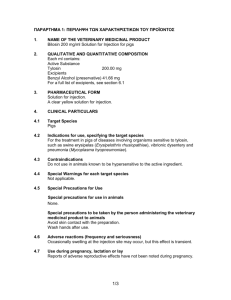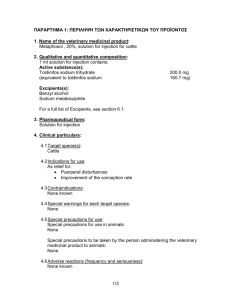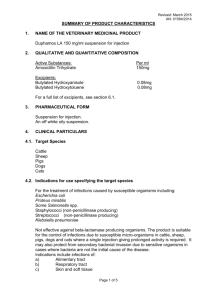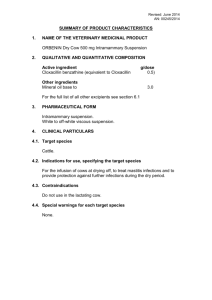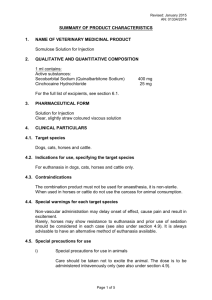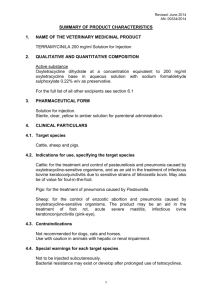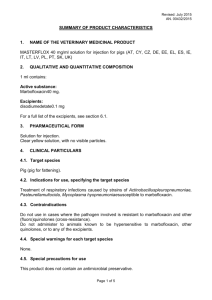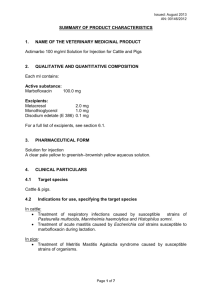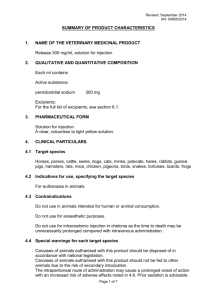ADVOCIN 180, 180 mg/ml, Solution for Injection for Cattle
advertisement
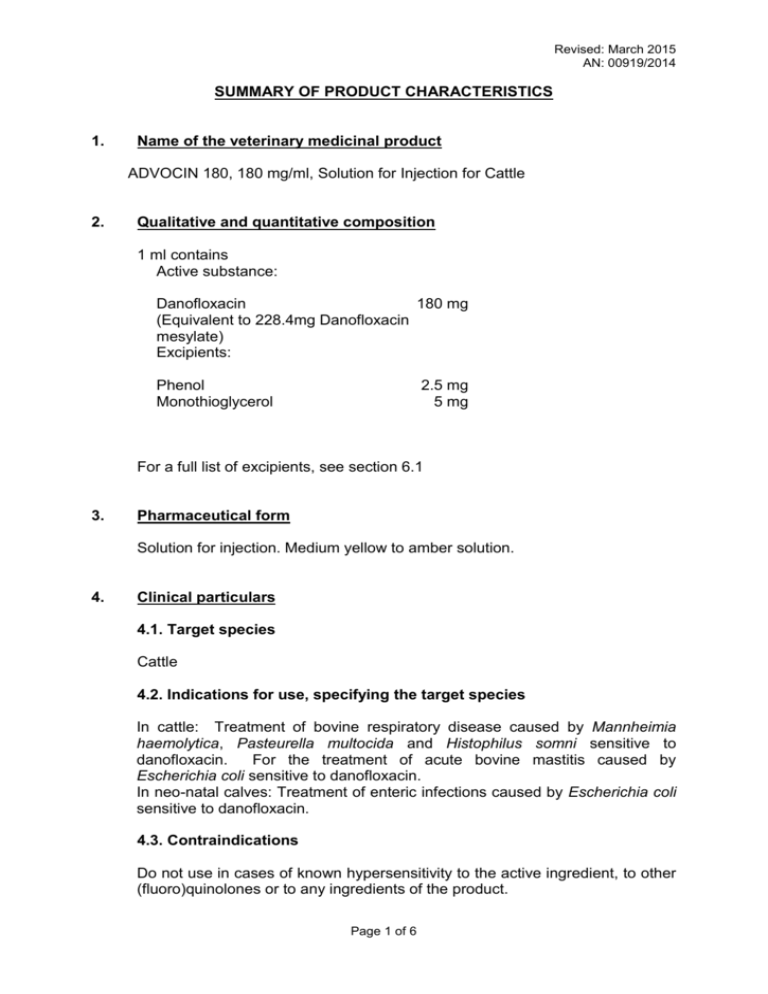
Revised: March 2015 AN: 00919/2014 SUMMARY OF PRODUCT CHARACTERISTICS 1. Name of the veterinary medicinal product ADVOCIN 180, 180 mg/ml, Solution for Injection for Cattle 2. Qualitative and quantitative composition 1 ml contains Active substance: Danofloxacin 180 mg (Equivalent to 228.4mg Danofloxacin mesylate) Excipients: Phenol Monothioglycerol 2.5 mg 5 mg For a full list of excipients, see section 6.1 3. Pharmaceutical form Solution for injection. Medium yellow to amber solution. 4. Clinical particulars 4.1. Target species Cattle 4.2. Indications for use, specifying the target species In cattle: Treatment of bovine respiratory disease caused by Mannheimia haemolytica, Pasteurella multocida and Histophilus somni sensitive to danofloxacin. For the treatment of acute bovine mastitis caused by Escherichia coli sensitive to danofloxacin. In neo-natal calves: Treatment of enteric infections caused by Escherichia coli sensitive to danofloxacin. 4.3. Contraindications Do not use in cases of known hypersensitivity to the active ingredient, to other (fluoro)quinolones or to any ingredients of the product. Page 1 of 6 Revised: March 2015 AN: 00919/2014 4.4. Special warnings for each target species The safety of the product has not been assessed in breeding bulls. 4.5. Special precautions for use i) Special precautions for use in animals Use of fluoroquinolones should be based on susceptibility testing and take into account official and local antimicrobial use policies. It is prudent to reserve fluoroquinolones for the treatment of clinical conditions which have responded poorly, or are expected to respond poorly, to other classes of antimicrobials. Efficacy against gram positive strains has not been established. For fluoroquinolones as a class, over-dosage at multiples of the recommended dose has been shown to induce erosion of articular cartilage. Care should be taken to dose accurately and the product should be used with caution in animals with joint disease or cartilage growth disorders. Use of the product deviating from the instructions given in the SPC may increase the prevalence of bacteria resistant to fluoroquinolones and may decrease the effectiveness of treatment with other quinolones due to the potential for cross resistance. Do not use in cases where the pathogen involved is resistant to other fluoroquinolones (due to the potential for cross resistance). ii) Special precautions to be taken by the person administering the medicinal products to animals Persons with known hypersensitivity to (fluoro)quinolones should avoid contact with the product. Care should be taken to avoid accidental self injection, it can induce a slight irritation. In case of accidental self injection, seek medical advice and show the package leaflet or the label to the physician. In case of contact with skin or eyes, rinse with plenty of water. Wash hands after use. Do not eat, drink or smoke during application. iii) Other precautions 4.6. Adverse reactions (frequency and seriousness) In very rare cases in sensitive animals, immediate or delayed anaphylactic shock may occur after the injection. Page 2 of 6 Revised: March 2015 AN: 00919/2014 Subcutaneous injection of the product induces a moderate inflammatory response in the tissue around the injection site. The resultant lesions may persist for up to 30 days. 4.7. Use during pregnancy, lactation or lay Studies in laboratory animals have shown adverse effects on reproduction. At high doses in rats (100 to 200 mg/kg/day), increase in foetal delayed ossification and in dilatation of the cerebral ventricles were observed. Dams given high dose produced fewer live pups per litter and pup weight and survival were adversely affected. The safety of the product has not been assessed in pregnant cows. The use of the product is not recommended for cows during pregnancy. 4.8. Interaction with other medicinal products and other forms of interaction When fluoroquinolones have been combined with bacteriostatic antimicrobials, such as tetracyclines and macrolides or phenicols, an antagonism was demonstrated in vitro. 4.9. Amount(s) to be administered and administration route 6 mg/kg body weight (1 ml/30 kg body weight) as a single injection by the subcutaneous or intravenous route. If clinical signs of respiratory or enteric disease persist 48 hours after the first injection, an additional dose at 6 mg/kg body weight may be administered. It is recommended to treat animals in the early stages of disease and to evaluate the response to treatment within 48 hours. For the treatment of acute bovine mastitis, the product should be administered at 6 mg/kg body weight (1 ml/30 kg body weight) as a single injection by the subcutaneous or intravenous route. The clinical signs should be monitored carefully and supportive therapy should be given as appropriate. If clinical signs of acute bovine mastitis persist 36-48 hours after the first injection, the antibiotic treatment strategy should be reviewed. It is recommended to treat animals in the early stages of disease and to evaluate the response to treatment within 36-48 hours. For treatment of cattle weighing more than 450 kg, divide the subcutaneous dose so that no more than 15 ml are injected at one site. When dosing a large number of animals from a single vial, the use of an automatic syringe is recommended to avoid excessive broaching of the rubber stopper. To ensure a correct dosage body weight should be determined as accurately as possible to avoid underdosing. Page 3 of 6 Revised: March 2015 AN: 00919/2014 4.10. Overdose (symptoms, emergency procedures, antidotes), if necessary At doses of three times the therapeutic dose (18 mg/kg bw), erythema of the nasal and ocular mucosae was induced and food intake was reduced. At even higher doses and prolonged exposure, there was damage to the cartilage in the joints and some animals displayed paresis, ataxia or nystagmus. 4.11. Withdrawal period(s) Meat and offal: Milk: 5. 8 days 4 days Pharmacological properties Pharmacotherapeutic group: Fluoroquinolones, ATCvet code: QJ01MA92 5.1. Pharmacodynamic properties Danofloxacin is a synthetic fluoroquinolone antimicrobial agent that possesses potent in vitro activity against Mannheimia haemolytica, Pasteurella multocida, Histophilus somni and Escherichia coli, the bacterial pathogens most commonly associated with bovine respiratory, enteric disease and acute bovine mastitis. The antimicrobial activity of danofloxacin is based upon the inhibition of microbial DNA gyrase and topoisomerase IV. The inhibitory effect is on the second step of the enzymatic process, uncoupling the breakage and reunion functions. Danofloxacin, in common with other fluoroquinolones, produces a stable complex between the enzyme and DNA. This results in the cessation of DNA replication and transcription. The bactericidal effect is also observed on bacteria in the stationary growth phase. 5.2. Pharmacokinetic particulars The product is rapidly and extensively absorbed from the site of subcutaneous injection, bioavailability is around 90%. Danofloxacin is only poorly metabolised and subsequently eliminated via both the renal and hepatic routes. A difference in elimination kinetics is observed between pre-ruminant animals (half-life of 12 hours) and ruminant animals (half-life of 4 hours). High drug concentrations in lung, enteric and lymphatic tissues are observed. Following a single subcutaneous administration at 6 mg/kg body weight, peak plasma and tissue concentrations are achieved within one to two hours after treatment, with concentrations in lung and enteric tissues approximately four times greater than in plasma. The dose selected for the product was based Page 4 of 6 Revised: March 2015 AN: 00919/2014 on the optimisation of the concentration dependent bactericidal activity of danofloxacin against respiratory and enteric pathogens. The mean milk concentrations of danofloxacin were 4.61 and 0.2 µg/ml at the 8 and 24 hour milking, respectively, following a single subcutaneous injection. 6. Pharmaceutical particulars 6.1. List of excipients Phenol Monothioglycerol Povidone K 15 2-pyrrolidone Magnesium oxide Hydrochloric acid Sodium hydroxide Water for injection 6.2. Incompatibilities In the absence of compatibility studies, this veterinary medicinal product must not be mixed with other veterinary medicinal products. 6.3. Shelf-life Shelf-life of the veterinary medicinal product as packaged for sale: 2 years. Shelf-life after first opening of the immediate packaging: 28 days. 6.4. Special precautions for storage Store in the original packaging in order to protect from light. Do not freeze. 6.5. Nature and composition of immediate packaging Nature of Primary Packaging Type I amber glass vial Chlorobutyl rubber stopper Aluminium overseal with polypropylene cover Market Presentations Box containing one 50 ml vial Box containing one 100 ml vial Box containing one 250 ml vial Not all pack sizes may be marketed. Page 5 of 6 Revised: March 2015 AN: 00919/2014 6.6. Special precautions for the disposal of unused veterinary medicinal product or waste materials derived from the use of such products Any unused veterinary medicinal product or waste materials derived from such veterinary medicinal products should be disposed of in accordance with local requirements. 7. MARKETING AUTHORISATION HOLDER Zoetis UK Limited 5th Floor, 6 St. Andrew Street London EC4A 3AE 8. MARKETING AUTHORISATION NUMBER Vm: 42058/4000 9. DATE OF FIRST AUTORISATION Date : 16 November 2001 10. DATE OF REVISION OF THE TEXT Date: March 2015 Approved: 29 May 2015 Page 6 of 6
